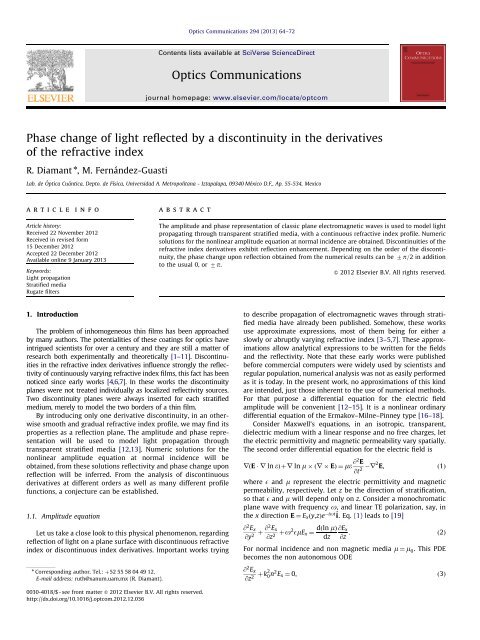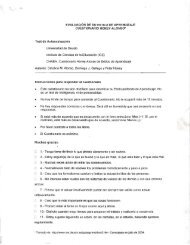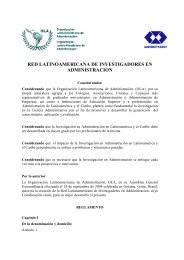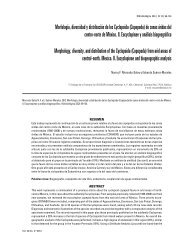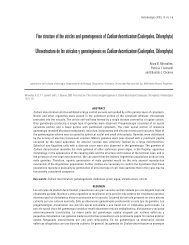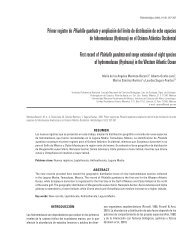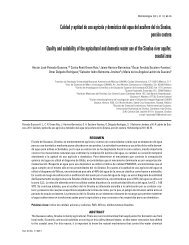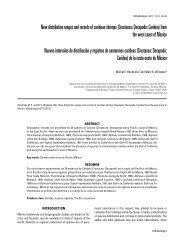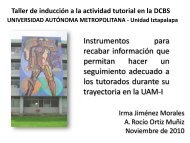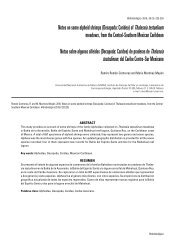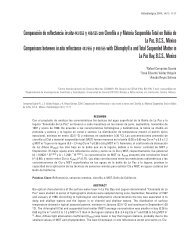Phase change of light reflected by a discontinuity in the derivatives ...
Phase change of light reflected by a discontinuity in the derivatives ...
Phase change of light reflected by a discontinuity in the derivatives ...
Create successful ePaper yourself
Turn your PDF publications into a flip-book with our unique Google optimized e-Paper software.
Optics Communications 294 (2013) 64–72Contents lists available at SciVerse ScienceDirectOptics Communicationsjournal homepage: www.elsevier.com/locate/optcom<strong>Phase</strong> <strong>change</strong> <strong>of</strong> <strong>light</strong> <strong>reflected</strong> <strong>by</strong> a <strong>discont<strong>in</strong>uity</strong> <strong>in</strong> <strong>the</strong> <strong>derivatives</strong><strong>of</strong> <strong>the</strong> refractive <strong>in</strong>dexR. Diamant n , M. Fernández-GuastiLab. de Óptica Cuántica, Depto. de Física, Universidad A. Metropolitana - Iztapalapa, 09340 México D.F., Ap. 55-534, Mexicoarticle <strong>in</strong>foArticle history:Received 22 November 2012Received <strong>in</strong> revised form15 December 2012Accepted 22 December 2012Available onl<strong>in</strong>e 9 January 2013Keywords:Light propagationStratified mediaRugate filtersabstractThe amplitude and phase representation <strong>of</strong> classic plane electromagnetic waves is used to model <strong>light</strong>propagat<strong>in</strong>g through transparent stratified media, with a cont<strong>in</strong>uous refractive <strong>in</strong>dex pr<strong>of</strong>ile. Numericsolutions for <strong>the</strong> nonl<strong>in</strong>ear amplitude equation at normal <strong>in</strong>cidence are obta<strong>in</strong>ed. Discont<strong>in</strong>uities <strong>of</strong> <strong>the</strong>refractive <strong>in</strong>dex <strong>derivatives</strong> exhibit reflection enhancement. Depend<strong>in</strong>g on <strong>the</strong> order <strong>of</strong> <strong>the</strong> <strong>discont<strong>in</strong>uity</strong>,<strong>the</strong> phase <strong>change</strong> upon reflection obta<strong>in</strong>ed from <strong>the</strong> numerical results can be 7p=2 <strong>in</strong> additionto <strong>the</strong> usual 0, or 7p.& 2012 Elsevier B.V. All rights reserved.1. IntroductionThe problem <strong>of</strong> <strong>in</strong>homogeneous th<strong>in</strong> films has been approached<strong>by</strong> many authors. The potentialities <strong>of</strong> <strong>the</strong>se coat<strong>in</strong>gs for optics have<strong>in</strong>trigued scientists for over a century and <strong>the</strong>y are still a matter <strong>of</strong>research both experimentally and <strong>the</strong>oretically [1–11]. Discont<strong>in</strong>uities<strong>in</strong> <strong>the</strong> refractive <strong>in</strong>dex <strong>derivatives</strong> <strong>in</strong>fluence strongly <strong>the</strong> reflectivity<strong>of</strong> cont<strong>in</strong>uously vary<strong>in</strong>g refractive <strong>in</strong>dex films, this fact has beennoticed s<strong>in</strong>ce early works [4,6,7]. In <strong>the</strong>se works <strong>the</strong> <strong>discont<strong>in</strong>uity</strong>planes were not treated <strong>in</strong>dividually as localized reflectivity sources.Two <strong>discont<strong>in</strong>uity</strong> planes were always <strong>in</strong>serted for each stratifiedmedium, merely to model <strong>the</strong> two borders <strong>of</strong> a th<strong>in</strong> film.By <strong>in</strong>troduc<strong>in</strong>g only one derivative <strong>discont<strong>in</strong>uity</strong>, <strong>in</strong> an o<strong>the</strong>rwisesmooth and gradual refractive <strong>in</strong>dex pr<strong>of</strong>ile, we may f<strong>in</strong>d itsproperties as a reflection plane. The amplitude and phase representationwill be used to model <strong>light</strong> propagation throughtransparent stratified media [12,13]. Numeric solutions for <strong>the</strong>nonl<strong>in</strong>ear amplitude equation at normal <strong>in</strong>cidence will beobta<strong>in</strong>ed, from <strong>the</strong>se solutions reflectivity and phase <strong>change</strong> uponreflection will be <strong>in</strong>ferred. From <strong>the</strong> analysis <strong>of</strong> discont<strong>in</strong>uous<strong>derivatives</strong> at different orders as well as many different pr<strong>of</strong>ilefunctions, a conjecture can be established.1.1. Amplitude equationLet us take a close look to this physical phenomenon, regard<strong>in</strong>greflection <strong>of</strong> <strong>light</strong> on a plane surface with discont<strong>in</strong>uous refractive<strong>in</strong>dex or discont<strong>in</strong>uous <strong>in</strong>dex <strong>derivatives</strong>. Important works try<strong>in</strong>gn Correspond<strong>in</strong>g author. Tel.: þ52 55 58 04 49 12.E-mail address: ruth@xanum.uam.mx (R. Diamant).to describe propagation <strong>of</strong> electromagnetic waves through stratifiedmedia have already been published. Somehow, <strong>the</strong>se worksuse approximate expressions, most <strong>of</strong> <strong>the</strong>m be<strong>in</strong>g for ei<strong>the</strong>r aslowly or abruptly vary<strong>in</strong>g refractive <strong>in</strong>dex [3–5,7]. These approximationsallow analytical expressions to be written for <strong>the</strong> fieldsand <strong>the</strong> reflectivity. Note that <strong>the</strong>se early works were publishedbefore commercial computers were widely used <strong>by</strong> scientists andregular population, numerical analysis was not as easily performedas it is today. In <strong>the</strong> present work, no approximations <strong>of</strong> this k<strong>in</strong>dare <strong>in</strong>tended, just those <strong>in</strong>herent to <strong>the</strong> use <strong>of</strong> numerical methods.For that purpose a differential equation for <strong>the</strong> electric fieldamplitude will be convenient [12–15]. It is a nonl<strong>in</strong>ear ord<strong>in</strong>arydifferential equation <strong>of</strong> <strong>the</strong> Ermakov–Milne–P<strong>in</strong>ney type [16–18].Consider Maxwell’s equations, <strong>in</strong> an isotropic, transparent,dielectric medium with a l<strong>in</strong>ear response and no free charges, let<strong>the</strong> electric permittivity and magnetic permeability vary spatially.The second order differential equation for <strong>the</strong> electric field isrðE r ln eÞþr ln m ðr EÞ¼me @2 Er 2 E, ð1Þ@t 2where E and m represent <strong>the</strong> electric permittivity and magneticpermeability, respectively. Let z be <strong>the</strong> direction <strong>of</strong> stratification,so that E and m will depend only on z. Consider a monochromaticplane wave with frequency o, and l<strong>in</strong>ear TE polarization, say, <strong>in</strong><strong>the</strong> x direction E ¼ E x ðy,zÞe iot^i. Eq. (1) leads to [19]@ 2 E x@y þ @2 E x2 @z 2 þo2 EmE x ¼dðln mÞ @E xdz @z :For normal <strong>in</strong>cidence and non magnetic media m ¼ m 0 . This PDEbecomes <strong>the</strong> non autonomous ODE@ 2 E x@z 2 þk2 0 n2 E x ¼ 0, ð3Þð2Þ0030-4018/$ - see front matter & 2012 Elsevier B.V. All rights reserved.http://dx.doi.org/10.1016/j.optcom.2012.12.036
R. Diamant, M. Fernández-Guasti / Optics Communications 294 (2013) 64–72 65where k 2 0 ¼ po2 m 0 E 0 and <strong>the</strong> refractive <strong>in</strong>dex is n ¼ E=E ffiffiffiffiffiffiffiffiffi0,E0 is <strong>the</strong> To model a s<strong>in</strong>gle <strong>in</strong>terface, n(z) must be a monotonic cont<strong>in</strong>uousA 2 d ¼ 1 The parameter D is a measure <strong>of</strong> <strong>the</strong> <strong>in</strong>terface thickness, correspond<strong>in</strong>g to 90% <strong>of</strong>n : ð12Þ <strong>the</strong> <strong>in</strong>dex <strong>change</strong>. The overall refractive <strong>in</strong>dex <strong>change</strong> is labeled Dn and <strong>the</strong> halfvalue<strong>by</strong> n avg. The figure shows a pr<strong>of</strong>ile with D ¼ 2l.electric permittivity <strong>of</strong> vacuum. Now, consider a complex E x ,namely E x ¼ Ae iq , where <strong>the</strong> amplitude A and phase q depend onz. We restrict <strong>the</strong> problem to non absorb<strong>in</strong>g media, so we willassume <strong>the</strong> refractive <strong>in</strong>dex to be a real quantity. Substitution <strong>in</strong>function evolv<strong>in</strong>g from n i to n t . Far from <strong>the</strong> <strong>in</strong>terface n should bealmost constant. To evaluate <strong>the</strong> reflectivity, <strong>the</strong> convenient <strong>in</strong>itialcondition is a s<strong>in</strong>gle transmitted wave through <strong>the</strong> second medium,so <strong>the</strong> <strong>in</strong>cident <strong>light</strong> is assumed to come only from <strong>the</strong> first mediumEq. (3) and separation <strong>of</strong> real and imag<strong>in</strong>ary parts render:side. This implies that <strong>the</strong> solution <strong>in</strong> <strong>the</strong>psecond medium, far fromd 2 AA dq 2<strong>the</strong> <strong>in</strong>terface, is almost constant A d ¼ffiffiffiffiffiffiffiffiffiffi1=n t.Under this condition,¼ k 2dz 20dzA, ð4Þ <strong>the</strong> amplitude oscillations <strong>in</strong> <strong>the</strong> first medium, far from <strong>the</strong> <strong>in</strong>terface,will exhibit <strong>the</strong> medium’s reflectivity: R ¼ r 2 . Given <strong>the</strong> <strong>in</strong>dices n i2 dA and n t , we expect <strong>the</strong> reflectivity to depend on <strong>the</strong> <strong>in</strong>terfacedqþA d2 qdz dz dz ¼ 0:ð5Þ abruptness. This property can be characterized <strong>by</strong> <strong>the</strong> distance D2 through which <strong>the</strong> <strong>in</strong>dex varies from n i þð1=20ÞDn to n t ð1=20ÞDn,Eq. (5) can be readily <strong>in</strong>tegrated to obta<strong>in</strong> an <strong>in</strong>variant quantitygiven <strong>by</strong>so that parameter D can be thought as <strong>the</strong> <strong>in</strong>terface thickness,correspond<strong>in</strong>g to 90% <strong>of</strong> <strong>the</strong> <strong>in</strong>dex <strong>change</strong> as shown <strong>in</strong> Fig. 1.In an earlier paper [13] studies <strong>of</strong> <strong>the</strong> <strong>in</strong>terface reflectivity,Q ¼ A 2 dqdz :ð6Þ given different pr<strong>of</strong>iles with vary<strong>in</strong>g thicknesses, have been done.All pr<strong>of</strong>iles were cont<strong>in</strong>uous, but some were piecewise def<strong>in</strong>edA nonl<strong>in</strong>ear ord<strong>in</strong>ary differential equation for <strong>the</strong> amplitude isobta<strong>in</strong>ed upon substitution <strong>of</strong> this result <strong>in</strong> Eq. (4)and <strong>the</strong>ir <strong>derivatives</strong> were discont<strong>in</strong>uous. For ‘‘hard’’ <strong>in</strong>terfaces,mean<strong>in</strong>g D l=100, reflectivity was close to <strong>the</strong> Fresnel resultd 2 A Q 2dz 2 A ¼ 3 k2 0 n2 A: ð7Þ R ¼ n t n 2i,n t þn iThis is an Ermakov–Milne–P<strong>in</strong>ney type equation. In order to work regardless <strong>of</strong> <strong>the</strong> pr<strong>of</strong>ile type. For ‘‘s<strong>of</strong>ter’’ <strong>in</strong>terfaces, D l=2, <strong>the</strong>withpa dimensionless amplitude function let us <strong>in</strong>troduceA d ¼ Affiffiffiffiffiffiffiffiffiffiffireflectivity <strong>of</strong> almost all n(z) pr<strong>of</strong>iles fell to less than 6% <strong>of</strong> <strong>the</strong> Fresnelk 0 =Q, <strong>the</strong>n Eq. (7) can be rewrittenresult. The reflectivity for <strong>the</strong> analytic pr<strong>of</strong>iles dropped monotonicallyd 2 1for D4l. In contrast, for <strong>the</strong> piecewise def<strong>in</strong>ed pr<strong>of</strong>iles, <strong>the</strong> reflectivityoscillates as a function <strong>of</strong> thickness. Every piecewise def<strong>in</strong>edA d¼ n 2 Ak 2 0 dz2 A 3 d : ð8Þdpr<strong>of</strong>ile had two attachment planes, at z 1 and z 2 , <strong>in</strong> order to keep <strong>the</strong>This is <strong>the</strong> ord<strong>in</strong>ary differential equation for <strong>the</strong> electric fieldamplitude. It is not common to turn a l<strong>in</strong>ear differential equation<strong>in</strong>terface symmetry and a bounded refractive <strong>in</strong>dex. The reflectivityoscillations <strong>in</strong> <strong>the</strong>se cases were <strong>in</strong> accordance with th<strong>in</strong> film <strong>in</strong>terference,<strong>in</strong>to a nonl<strong>in</strong>ear ODE, but Eq. (8) poses no challenge to be solvedwith a film thickness <strong>of</strong> z 2 z 1 . Evidently discont<strong>in</strong>uities <strong>in</strong>numerically if A d is real and n is bounded. Also, <strong>in</strong>itial conditionsare easily imposed hav<strong>in</strong>g a clear physical mean<strong>in</strong>g and f<strong>in</strong>ally,<strong>in</strong>terpretation <strong>of</strong> <strong>the</strong> solutions is straightforward. The f<strong>in</strong>itedifference method for numerically solv<strong>in</strong>g ord<strong>in</strong>ary differentialequations is used, with s<strong>in</strong>gle precision float<strong>in</strong>g po<strong>in</strong>t numbers.<strong>the</strong> pr<strong>of</strong>ile <strong>derivatives</strong> were caus<strong>in</strong>g reflections. However, it was notclear, only from <strong>the</strong> <strong>in</strong>terference data, which type <strong>of</strong> phase <strong>change</strong>was <strong>the</strong> <strong>reflected</strong> wave undergo<strong>in</strong>g at <strong>the</strong> z 1 and z 2 boundaries. Wecould only <strong>in</strong>fer <strong>the</strong> relative phase between <strong>the</strong> two reflections. Ourtask now is to evaluate <strong>the</strong> phase <strong>change</strong> upon reflection, based on<strong>the</strong> <strong>in</strong>terpretation <strong>of</strong> <strong>the</strong> amplitude equation numerical solutions.1.2. Interpretation <strong>of</strong> <strong>the</strong> solutionsA good example <strong>of</strong> how <strong>the</strong> junctions <strong>of</strong> a cont<strong>in</strong>uous butpiecewise n(z) function still generate reflection, even when <strong>the</strong><strong>in</strong>terface is gradual, is shown <strong>in</strong> Fig. 2. The bottom graph displaysA constant n represents a homogeneous medium, <strong>in</strong> this casereflectivity R versus <strong>in</strong>terface thickness D, <strong>in</strong> wavelength units, for<strong>the</strong> solutions <strong>of</strong> Eq. (8) are known and must be <strong>of</strong> <strong>the</strong> formtwo n(z) pr<strong>of</strong>ile types. Both pr<strong>of</strong>iles are cont<strong>in</strong>uous but one <strong>of</strong>[12–14,20]:<strong>the</strong>m, labeled as ‘‘tanh’’, is analytic and <strong>the</strong> o<strong>the</strong>r, ‘‘l<strong>in</strong>ear’’, isqffiffiffiffiffiffiffiffiffiffiffiffiffiffiffiffiffiffiffiffiffiffiffiffiffiffiffiffiffiffiffiffiffiffiffiffiffiffiffiffiffiffiffiffiffiffiffiffiffiffiffiffiffiffiffiffiffiffiffiffiffiffiffiffiA d ¼ A 2 1 þA2 2 þ2A 1A 2 cosð2k 0 nzþdÞ: ð9ÞThe field amplitude A d is produced <strong>by</strong> <strong>the</strong> superposition <strong>of</strong> twocounter propagat<strong>in</strong>g waves, with <strong>in</strong>dividual constant amplitudesA 1 and A 2 . The constant d is <strong>the</strong> phase difference between bothwaves at z¼0. There is a restriction for <strong>the</strong>se amplitudes if Eq. (8)is to be satisfied:ðA 2 1 A 2 2 Þ2 ¼ 1 n : 2 ð10ÞThis homogeneous medium solution A d (z) oscillates periodically ifboth, A 1 and A 2 , are nonzero. Maxima A max and m<strong>in</strong>ima A m<strong>in</strong> occurwhen <strong>the</strong> <strong>in</strong>com<strong>in</strong>g and outgo<strong>in</strong>g waves are <strong>in</strong> or out <strong>of</strong> phase,respectively. These extrema can also be related to <strong>the</strong> ratior ¼ A 2 =A 1 [12,13]:r ¼ A max A m<strong>in</strong>:A max þA m<strong>in</strong>ð11ÞIf <strong>the</strong>re is only one wave propagat<strong>in</strong>g, A 1 or A 2 is zero and A d isconstant, particularlyFig. 1. To model a s<strong>in</strong>gle <strong>in</strong>terface, n(z) must be a monotonic cont<strong>in</strong>uous functionthat evolves from n i to n t . Far from <strong>the</strong> <strong>in</strong>terface n should be practically constant.
R. Diamant, M. Fernández-Guasti / Optics Communications 294 (2013) 64–72 67Fig. 3. Amplitude equation solutions for (a) ‘‘stepþ’’, n i ¼ 1, n t ¼ 1:5 and (b) ‘‘step’’, n i ¼ 1:5, n t ¼ 1. The junction is at z¼0.Fig. 4. (a) Plot <strong>of</strong> <strong>the</strong> pr<strong>of</strong>ile <strong>in</strong> Eq. (17) ‘‘l<strong>in</strong>&tanh’’, it is constructed <strong>by</strong> jo<strong>in</strong><strong>in</strong>g a constant function with a hyperbolic tangent. It models a gradual <strong>in</strong>terface with D ¼ 2l andone <strong>discont<strong>in</strong>uity</strong> <strong>in</strong> <strong>the</strong> first derivative at z¼0, where this derivative is <strong>in</strong>creas<strong>in</strong>g. The amplitude equation solution A d for ‘‘l<strong>in</strong>&tanhþ’’ pr<strong>of</strong>ile is also shown and (b) acloser look at <strong>the</strong> solution <strong>in</strong> <strong>the</strong> oscillat<strong>in</strong>g region.<strong>the</strong>se waves po<strong>in</strong>t <strong>in</strong> opposite directions; if <strong>the</strong>re is a maximum, itmeans <strong>the</strong> fields po<strong>in</strong>t <strong>in</strong> <strong>the</strong> same direction. If maxima occur atL max ¼ ð ð1=4Þ ðm=2ÞÞl and m<strong>in</strong>ima at L m<strong>in</strong> ¼ ðm=2Þl, form ¼ 0,1,2,3 ..., <strong>the</strong> electric field waves must have phase difference<strong>of</strong> d ¼ p between <strong>the</strong>m at z¼0 (<strong>the</strong> <strong>discont<strong>in</strong>uity</strong> site), thusreveal<strong>in</strong>g a phase <strong>change</strong> <strong>of</strong> p due to reflection at <strong>the</strong> junctionplane. If maxima and m<strong>in</strong>ima positions are <strong>in</strong>ter<strong>change</strong>d, wavesmust be <strong>in</strong> phase at z¼0, reveal<strong>in</strong>g no phase <strong>change</strong> due toreflection at <strong>the</strong> junction plane. For <strong>the</strong> former <strong>in</strong>terpretation tobe valid, <strong>the</strong> refractive <strong>in</strong>dex n(z) must be reasonably constantalong <strong>the</strong> <strong>in</strong>terval where <strong>the</strong> local extrema are found.The location <strong>of</strong> <strong>the</strong> critical po<strong>in</strong>ts for <strong>the</strong> ‘‘stepþ’’ case, showsan approximate phase <strong>change</strong> <strong>of</strong> p upon reflection at z¼0. Thereis a mean <strong>of</strong>fset <strong>of</strong> ð0:004Þp from <strong>the</strong> exact d ¼ p value with verysmall deviation (sop=1000). For ‘‘step ’’, maxima fall close toL max ¼ ðm=2Þl and m<strong>in</strong>ima at L m<strong>in</strong> ¼ ð ð1=4Þ m=2Þl, reveal<strong>in</strong>gan almost null phase <strong>change</strong> due to reflection at <strong>the</strong> junction.However, <strong>the</strong>re is a mean <strong>of</strong>fset <strong>of</strong> ð0:004Þp from <strong>the</strong> exact d ¼ 0value with standard deviation <strong>of</strong> s ¼ð0:002Þp. These resultsmatch very well with Fresnel predictions.4. Gradual and cont<strong>in</strong>uous <strong>in</strong>terfaces4.1. Type C 0 pr<strong>of</strong>ilesA type C 0 pr<strong>of</strong>ile with only one piecewise junction can beconstructed <strong>by</strong> jo<strong>in</strong><strong>in</strong>g a constant function with a hyperbolictangent at z¼0:(n l<strong>in</strong>&tanh þ ðzÞ¼ n a zo0n a þðn g n a Þ tanh a 1Dz ð17ÞzZ0,Herea 1 ¼ 1 1:95ln ln 1:05 ,2 0:05 0:95so that D is <strong>the</strong> <strong>in</strong>terface thickness, <strong>the</strong> distance needed for n to<strong>change</strong> 90% <strong>of</strong> <strong>the</strong> total Dn ¼ n g n a . The function n l<strong>in</strong>&tanh þ ðzÞ iscont<strong>in</strong>uous, at <strong>the</strong> junction it is <strong>in</strong>creas<strong>in</strong>g while its derivativedn=dz is discont<strong>in</strong>uous and is also <strong>in</strong>creas<strong>in</strong>g. Interface thicknessis chosen to be reasonably s<strong>of</strong>t D ¼ 2l to discard any significantsource <strong>of</strong> reflection except at <strong>the</strong> junction. Fig. 4(a) shows a plot <strong>of</strong>this pr<strong>of</strong>ile. Light is always assumed to be <strong>in</strong>cident from <strong>the</strong> left.The numerical solution <strong>of</strong> <strong>the</strong> correspond<strong>in</strong>g amplitude equation(8) is also plotted <strong>in</strong> Fig. 4.In <strong>the</strong> case <strong>of</strong> ‘‘l<strong>in</strong>&tanhþ’’ pr<strong>of</strong>ile, apply<strong>in</strong>g Eq. (11) for zo0,<strong>the</strong> reflectivity is found to be R l<strong>in</strong>&tanh þ ¼ 3:15565 10 2 %, with astandard deviation <strong>of</strong> s R ¼ 1:8 10 6 %. This reflectivity is muchsmaller than <strong>the</strong> abrupt <strong>in</strong>terface result 4%, s<strong>in</strong>ce it is related to avery gradual <strong>in</strong>terface (D ¼ 2l). Yet, it is still far greater than <strong>the</strong>reflectivity computed for <strong>the</strong> analytic ‘‘tanh’’ pr<strong>of</strong>ile stated <strong>in</strong> Eq.(13), with <strong>the</strong> same <strong>in</strong>terface thickness, R tanh ¼ 3:16840 10 10 %.The first derivative <strong>discont<strong>in</strong>uity</strong> <strong>in</strong> n(z), thus enhances <strong>the</strong>reflectivity substantially.To analyze phase relationship between <strong>in</strong>cident and <strong>reflected</strong>waves let us take as reference <strong>the</strong> reflection plane (always drawnat z¼0 <strong>in</strong> <strong>the</strong> figures). In this case, it lies where <strong>the</strong> first orderderivative is discont<strong>in</strong>uous, although <strong>the</strong> refractive <strong>in</strong>dex itself iscont<strong>in</strong>uous. The phase between <strong>in</strong>cident and <strong>reflected</strong> waves maybe evaluated at any such region with constant refractive <strong>in</strong>dex.However, it is easier to consider a plane located at a multiple <strong>of</strong><strong>the</strong> half-<strong>in</strong>teger wavelength, L ¼ mðl=2Þ where m is an <strong>in</strong>teger.From any <strong>of</strong> <strong>the</strong>se planes, <strong>the</strong> <strong>in</strong>cident wave travels to <strong>the</strong>reflection plane and <strong>the</strong>n <strong>the</strong> <strong>reflected</strong> part travels back an <strong>in</strong>teger
68R. Diamant, M. Fernández-Guasti / Optics Communications 294 (2013) 64–72number <strong>of</strong> wavelengths, and thus no phase needs to be added dueto <strong>the</strong> extra path traveled <strong>by</strong> this wave. If no phase <strong>change</strong> occurs<strong>by</strong> reflection at <strong>the</strong> derivative <strong>discont<strong>in</strong>uity</strong> (L ¼ 0), <strong>the</strong> <strong>reflected</strong>wave must be <strong>in</strong> phase with <strong>the</strong> <strong>in</strong>cident wave after m wavelengthstravel. However, consider <strong>the</strong> plane L ¼ 1:0l <strong>in</strong> Fig. 4(b).The <strong>in</strong>cident and <strong>reflected</strong> waves are not <strong>in</strong> phase. In <strong>the</strong> middlebetween one amplitude maximum and a contiguous m<strong>in</strong>imum,<strong>the</strong>se waves must have a relative phase difference <strong>of</strong> d ¼ 7ðp=2Þ.The numerical solution shown at L ¼ 1:0l <strong>in</strong> Fig. 4(b), reveals aphase difference <strong>of</strong> p=2. Therefore, <strong>the</strong>re must be a phase <strong>change</strong><strong>of</strong> d ¼ p=2 <strong>in</strong>troduced <strong>by</strong> <strong>the</strong> reflection at <strong>the</strong> plane where <strong>the</strong>derivative is discont<strong>in</strong>uous. A detailed analysis <strong>of</strong> <strong>the</strong> numericalsolution shows that <strong>the</strong>re is only a small <strong>of</strong>fset <strong>of</strong>ð 0:02470:004Þp=2 from <strong>the</strong> exact d ¼ p=2 value. This is certa<strong>in</strong>lya very surpris<strong>in</strong>g result, s<strong>in</strong>ce we know from Fresnel equations,that a phase <strong>change</strong> <strong>of</strong> p is <strong>in</strong>troduced between two transparentdielectric media when <strong>the</strong> refractive <strong>in</strong>dex is discont<strong>in</strong>uous and<strong>in</strong>creas<strong>in</strong>g. The present result shows that a phase <strong>change</strong> <strong>of</strong> p=2can be <strong>in</strong>troduced between two transparent dielectrics whoserefractive <strong>in</strong>dex is equal at <strong>the</strong> <strong>in</strong>terface but its first derivative isdiscont<strong>in</strong>uous. The former ‘‘l<strong>in</strong>&tanh’’ pr<strong>of</strong>ile is <strong>in</strong>creas<strong>in</strong>g at <strong>the</strong>junction plane as well as <strong>the</strong> derivative dn=dz, to see what wouldbe <strong>the</strong> case for an <strong>in</strong>creas<strong>in</strong>g pr<strong>of</strong>ile n(z) but decreas<strong>in</strong>g firstderivative dn=dz let us devise ano<strong>the</strong>r C 0 type pr<strong>of</strong>ile. Let us aga<strong>in</strong>piecewise jo<strong>in</strong> a hyperbolic tangent with a constant function atz¼0, but this time plac<strong>in</strong>g <strong>the</strong> hyperbolic tangent first:(n tanh&l<strong>in</strong> þ ðzÞ¼ n g þðn g n a Þ tanh a 1Dz zo0ð18ÞzZ0:n gOnce more, <strong>the</strong> <strong>in</strong>terface thickness is D ¼ 2l to discard anysignificant source <strong>of</strong> reflection except for <strong>the</strong> junction.Fig. 5(a) shows a plot <strong>of</strong> this pr<strong>of</strong>ile. Aga<strong>in</strong>, <strong>light</strong> is assumed tobe <strong>in</strong>cident from <strong>the</strong> left. Plots for <strong>the</strong> amplitude equation (8)numerical solution are shown <strong>in</strong> Fig. 5.In <strong>the</strong> case <strong>of</strong> ‘‘tanh&l<strong>in</strong>þ’’, Eq. (11) must be applied tooscillations at <strong>the</strong> far left, for Lt 4l, s<strong>in</strong>ce <strong>the</strong> medium is notsufficiently homogeneous closer to L ¼ 0. Oscillations are distortedwhen <strong>the</strong> refractive <strong>in</strong>dex varies considerably as a function<strong>of</strong> position. Computed reflectivity is R tanh&l<strong>in</strong> þ ¼ 6:27498 10 3 %with a standard deviation <strong>of</strong> s R ¼ 7:115 10 5 . The maxima andm<strong>in</strong>ima are approximately located at L max ¼ð1=8 m=2Þl andL m<strong>in</strong> ¼ð 1=8 m=2Þl, as seen <strong>by</strong> look<strong>in</strong>g at <strong>the</strong> <strong>in</strong>set <strong>in</strong> Fig. 5(b).The phase difference between <strong>in</strong>cident and <strong>reflected</strong> waves is veryclose to d ¼ p=2 atL ¼ m=2 reveal<strong>in</strong>g an approximate phase<strong>change</strong> <strong>of</strong> p=2 due to reflection at <strong>the</strong> junction plane. There is an<strong>of</strong>fset <strong>of</strong> ð 0:01070:002Þp from <strong>the</strong> exact d ¼ p=2 value. Thesign <strong>in</strong> d ¼ 7ðp=2Þ depends on whe<strong>the</strong>r <strong>the</strong> discont<strong>in</strong>uous derivative<strong>in</strong>creases or decreases, ra<strong>the</strong>r than on <strong>the</strong> refractive <strong>in</strong>dexvalues at <strong>the</strong> reflection plane.By <strong>in</strong>terchang<strong>in</strong>g <strong>the</strong> n a and n b refractive <strong>in</strong>dices for <strong>the</strong>‘‘l<strong>in</strong>&tanhþ’’ and ‘‘tanh&l<strong>in</strong>þ’’ pr<strong>of</strong>iles, one can generate ano<strong>the</strong>rtwo C 0 type pr<strong>of</strong>iles:(n l<strong>in</strong>&tanh ðzÞ¼ n g zo0n g þðn a n g Þ tanh a 1Dz ð19ÞzZ0(n tanh&l<strong>in</strong> ðzÞ¼ n a þðn a n g Þ tanh a 1Dz n azo0zZ0:ð20ÞWhile <strong>the</strong> refractive <strong>in</strong>dex pr<strong>of</strong>ile is decreas<strong>in</strong>g for both pr<strong>of</strong>iles,<strong>the</strong> first derivative is <strong>in</strong>creas<strong>in</strong>g <strong>in</strong> one case and decreas<strong>in</strong>g <strong>in</strong> <strong>the</strong>o<strong>the</strong>r. Perform<strong>in</strong>g <strong>the</strong> same analysis to <strong>the</strong> correspond<strong>in</strong>gFig. 5. (a) Plot <strong>of</strong> <strong>the</strong> pr<strong>of</strong>ile <strong>in</strong> Eq. (18) ‘‘tanh&l<strong>in</strong>’’, it is constructed <strong>by</strong> jo<strong>in</strong><strong>in</strong>g a hyperbolic tangent with a constant function. It models a gradual <strong>in</strong>terface with D ¼ 2l andone <strong>discont<strong>in</strong>uity</strong> <strong>in</strong> <strong>the</strong> first derivative at z¼0, where this derivative is decreas<strong>in</strong>g. The amplitude equation solution A d for ‘‘tanh&l<strong>in</strong>þ’’ pr<strong>of</strong>ile is also shown and (b) acloser look at <strong>the</strong> solution <strong>in</strong> <strong>the</strong> oscillat<strong>in</strong>g region.Table 2Calculated reflectivity and approximate phase difference d between <strong>in</strong>cident and <strong>reflected</strong> waves at <strong>the</strong> reflection plane, z¼0, related to <strong>the</strong> type C 0 pr<strong>of</strong>iles. The symbol s Rstands for <strong>the</strong> reflectivity standard deviation.C 0 function Reflectivity (%) R Reflectivity relative standarddeviation (%) s R 100Rl<strong>in</strong>&tanhþ 3:15565 10 2 0.0057 p2tanh&l<strong>in</strong>þ 6:27498 10 3 1.1 p2l<strong>in</strong>&tanh 6:24063 10 3 0.013 p2tanh&l<strong>in</strong> 3:16123 10 2 0.48 p2Approximate phase<strong>change</strong> at reflection plane z¼0Offset from <strong>the</strong> exact p 2 orpvalue <strong>in</strong> p units20:02470:0030:01470:0030:00570:0060:01970:005
R. Diamant, M. Fernández-Guasti / Optics Communications 294 (2013) 64–72 69amplitude equation solutions we arrive at similar outcomes asabridged for all four C 0 pr<strong>of</strong>iles <strong>in</strong> Table 2.4.1.1. Type C 1 pr<strong>of</strong>ilesTo build some C 1 type pr<strong>of</strong>iles, <strong>in</strong> a similar fashion as with <strong>the</strong>C 0 type, a constant function is piecewise jo<strong>in</strong>ed with a squaredhyperbolic secant at its critical po<strong>in</strong>t <strong>in</strong> four different ways,shown <strong>in</strong> Table 3. Plots <strong>of</strong> <strong>the</strong> numerical solutions for <strong>the</strong>amplitude equation (8), tak<strong>in</strong>g D ¼ 2l, are illustrated <strong>in</strong> Fig. 6.Reflectivity for type C 1 pr<strong>of</strong>iles, estimated with Eq. (11), andphase difference between <strong>in</strong>cident and <strong>reflected</strong> waves at <strong>the</strong>reflection plane are reported <strong>in</strong> Table 4. The reflectivity is evenlower for <strong>the</strong>se pr<strong>of</strong>iles. Incident and <strong>reflected</strong> waves are <strong>in</strong> phaseTable 3Type C 1 pr<strong>of</strong>iles. The piecewise junction is always at z¼0. Herepa 2 ¼ 1=2 lnð19Þþln½ð1þffiffiffiffiffiffiffiffiffiffi p0:95Þ=ð1þffiffiffiffiffiffiffiffiffiffi0:05ÞŠ so that D is <strong>the</strong> <strong>in</strong>terface thickness,<strong>the</strong> distance needed for n to <strong>change</strong> 90% <strong>of</strong> <strong>the</strong> total Dn ¼ n g n a.Function label n(z) d 2 nat <strong>the</strong> junction2dz8l<strong>in</strong>&sechþ < n a zo0n g ðn g n aÞ sech 2 a 2:D z zZ0sech&l<strong>in</strong>þ8n a þðn g n aÞ sech 2 a
70R. Diamant, M. Fernández-Guasti / Optics Communications 294 (2013) 64–72Fig. 7. Amplitude equation solutions for type C 2 pr<strong>of</strong>iles, a close look at <strong>the</strong> solutions <strong>in</strong> <strong>the</strong> oscillat<strong>in</strong>g regions. (a) Solutions for ‘‘l<strong>in</strong>&cubexpþ’’ and ‘‘cubexp&l<strong>in</strong>þ’’ and(b) solutions for ‘‘l<strong>in</strong>&cubexp ’’ and ‘‘cubexp&l<strong>in</strong> ’’.Table 6Calculated reflectivity and approximate phase difference d between <strong>in</strong>cident and <strong>reflected</strong> waves at <strong>the</strong> reflection plane, z¼0, related to <strong>the</strong> type C 2 pr<strong>of</strong>iles. The symbol s Rstands for <strong>the</strong> reflectivity standard deviation.C 2 function Reflectivity (%) R Reflectivity relativestandard deviation (%) s R 100Rl<strong>in</strong>&cubexpþ 1:33978 10 6 0.0045 p2cubexp&l<strong>in</strong>þ 5:15290 10 8 1.2 p2l<strong>in</strong>&cubexp 5:18475 10 8 0.020 p2cubexp&l<strong>in</strong> 1:33984 10 6 0.014 p2Approximate phase <strong>change</strong>at reflection plane z¼0Offset from <strong>the</strong> exact p 2 orpvalue <strong>in</strong> p units20:00170:0030:00470:0040:01570:0050:01170:005Table 7Type C 3 pr<strong>of</strong>iles. The piecewise junction is always at z¼0. Herepa 4 ¼ffiffiffiffiffiffiffiffiffiffiffiffiffiffiffiffiffi pffiffiffiffiffiffiffiffiffiffiffiffiffiffiffiffiffi44lnð0:95Þ lnð0:05Þ so that D is <strong>the</strong> <strong>in</strong>terface thickness, <strong>the</strong> distance neededfor n to <strong>change</strong> 90% <strong>of</strong> <strong>the</strong> total Dn ¼ n g n a.Label n(z) d 4 nat <strong>the</strong> junction4dz8l<strong>in</strong>&quartexpþ < n a zo0a 4:4n g ðn g n aÞ expD z zZ0quartexp&l<strong>in</strong>þ8
72R. Diamant, M. Fernández-Guasti / Optics Communications 294 (2013) 64–72[7] R. Jacobsson, V Light Reflection from Films <strong>of</strong> Cont<strong>in</strong>uously Vary<strong>in</strong>g RefractiveIndex, Progress <strong>in</strong> Optics, vol. 5., Elsevier, North-Holland, Amsterdamhttp://dx.doi.org/10.1016/S0079-6638(08)70454-2, pp. 247–286.[8] J.A. Dobrowolski, D. Lowe, Applied Optics 17 (19) (1978) 3039, http://dx.doi.org/10.1364/AO.17.003039. /http://ao.osa.org/abstract.cfm?URI=ao-17-19-3039S.[9] J.R. Jacobsson, Review <strong>of</strong> <strong>the</strong> optical properties <strong>of</strong> <strong>in</strong>homogeneous th<strong>in</strong> films,<strong>in</strong>: J.A. Dobrowolski, P.G. Verly, Proc. SPIE 2046 (Eds.), Inhomogeneous andQuasi-Inhomogeneous Optical Coat<strong>in</strong>gs, vol. 2., SPIE, Quebec City, Canada,http://dx.doi.org/10.1117/12.163540.[10] J.I. Larruquert, Journal <strong>of</strong> <strong>the</strong> Optical Society <strong>of</strong> America A 19 (2) (2002) 385,http://dx.doi.org/10.1364/JOSAA.19.000385. /http://josaa.osa.org/abstract.cfm?URI=josaa-19-2-385S.[11] S. Grafström, Journal <strong>of</strong> Optics A: Pure and Applied Optics 8 (2) (2006) 134,http://dx.doi.org/10.1088/1464-4258/8/2/005. /http://stacks.iop.org/1464-4258/8/i=2/a=005S.[12] M. Fernández-Guasti, A. Gil-Villegas, R. Diamant, Revista Mexicana de Física46 (6) (2000) 530.[13] R. Diamant, M. Fernández-Guasti, Journal <strong>of</strong> Optics A: Pure and AppliedOptics 11 (4) (2009) 045712, http://dx.doi.org/10.1088/1464-4258/11/4/045712.[14] R. Diamant, M. Fernández-Guasti, Reflected wave atypical phase <strong>change</strong> at aboundary, <strong>in</strong>: R. Rodríguez-Vera, R. Díaz-Uribe (Eds.), Proceed<strong>in</strong>gs <strong>of</strong> <strong>the</strong>22nd General Congress <strong>of</strong> <strong>the</strong> International Commission for Optics (ICO):Light for <strong>the</strong> Development <strong>of</strong> <strong>the</strong> World, vol. 8011 5U, SPIE, Puebla, Mexico,http://dx.doi.org/10.1117/12.901760.[15] M. Fernández-Guasti, R. Diamant, Stratified media: nonl<strong>in</strong>ear ODE is better,<strong>in</strong>: R. Rodríguez-Vera, R. Díaz-Uribe (Eds.), Proceed<strong>in</strong>gs <strong>of</strong> <strong>the</strong> 22nd GeneralCongress <strong>of</strong> <strong>the</strong> International Commission for Optics (ICO): Light for <strong>the</strong>Development <strong>of</strong> <strong>the</strong> World, vol. 8011 6D, SPIE, Puebla, Mexico, http://dx.doi.org/10.1117/12.903288.[16] V.P. Ermakov, Applicable Analysis and Discrete Ma<strong>the</strong>matics 2 (2008) 123,http://dx.doi.org/10.2298/AADM0802123E.[17] E. P<strong>in</strong>ney, The nonl<strong>in</strong>ear differential equation y’’ þ p(x) y þ c y(-3)¼0, <strong>in</strong>:Proceed<strong>in</strong>gs <strong>of</strong> <strong>the</strong> American Ma<strong>the</strong>matical Society, vol. 1, 1950, p. 681.http://dx.doi.org/10.1090/S0002-9939-1950-0037979-4.[18] P.G.L. Leach, K. Andriopoulos, Applicable Analysis and Discrete Ma<strong>the</strong>matics2 (2008) 146, http://dx.doi.org/10.2298/AADM0802146L.[19] M. Born, E. Wolf, Pr<strong>in</strong>ciples <strong>of</strong> Optics, 7th edition, Cambridge University Press,2005.[20] J.F. Cariñena, J. de Lucas, Physics Letters A 372 (33) (2008) 5385, http://dx.doi.org/10.1016/j.physleta.2008.06.053.[21] B.A. Barsky, T.D. DeRose, IEEE Computer Graphics and Applications 9 (6)(1989) 60, http://dx.doi.org/10.1109/38.41470.[22] Z. Knittl, Optics <strong>of</strong> Th<strong>in</strong> Films: An Optical Multilayer Theory, Wiley Series <strong>in</strong>Pure and Applied Optics, Wiley, 1976.[23] S.H. Russev, New derivation <strong>of</strong> <strong>the</strong> reversibility <strong>the</strong>orem for <strong>the</strong> optics <strong>of</strong>stratified media, Journal <strong>of</strong> Modern Optics 36 (8) (1989) 1139–1142, http://dx.doi.org/10.1080/09500348914551161.


